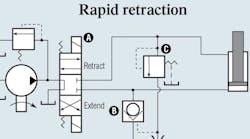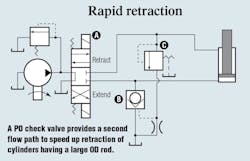Large-bore cylinders, with relatively large rods for handling large compressive loads, frequently are hampered by inadequate conductor or line capacity to exhaust oil rapidly from the cylinder during retraction. For example, to move a 10,000-lb tool head, a 6-in.-diameter cylinder with a 5 1/2-in. diameter rod would give adequate performance without threat of buckling the rod.
Assume a pump flow of 25 gpm. During extension, the lines and directional valve handle that flow easily. However, during retraction, the same pump flow to the rod end multiplies flow to 150 gpm from the cap end of the cylinders (with a piston-to-annular area ratio of 6:1).
Sequence valve C is set at a high enough opening pressure so that minor backpressure during extension does not inadvertently open check valve B.
This circuit design permits directional valve A to be sized according to the pump flow rather than the much larger volume of return flow during retraction. For the cylinder first described, pilot-operated check valve B may draw more than 100 gpm out of the circuit during retraction.
This circuit was submitted by Lew Tomer, of Fluid Controls Inc., Mentor, Ohio, and was originally published in the January 1984 issue of Hydraulics & Pneumatics.


